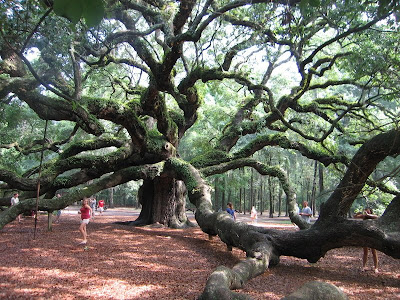It is not everyday that you get the opportunity to travel along these kind of roads in places that exist in the mist and the history of the past. Yes, we live in modern times, but when you really take account, some of the best things about us are in our history. As I was driving to Charleston I could not cease to stop here, there and everywhere to look at what was before me that even at a slow drive was passing by way too quickly. The results of these stops provided me with some of the greatest discoveries. I tend to read anything and everything historical and sometime ago I had read of the Angel Oak.
 This Southern Live Oak (Quercus virginiana) tree is approximately 1400 years old. It managed to survive Hugo that severely damaged a section of the tree, but it has managed to recover and continues to grow rather well. Even though the canopy in partially damaged, you still manage to see a magnificent specimen tree which has limbs that flow in the air like feathers to lenghts of 90 feet. Newton was right about gravity but seeing 90 foot horizontal limbs floating in air makes you question what is subject to gravity? In all the tree takes up about half an acre of land. It is monumental without question even though the Middleton Oak (stay tuned until next week) is purported to be the largest single trunk whereas the Angel Oak is supposed to be multiple trees that grew together to become siamese triplets or whatever. I can't tell how anyone can tell, but I will go along with the story.
This Southern Live Oak (Quercus virginiana) tree is approximately 1400 years old. It managed to survive Hugo that severely damaged a section of the tree, but it has managed to recover and continues to grow rather well. Even though the canopy in partially damaged, you still manage to see a magnificent specimen tree which has limbs that flow in the air like feathers to lenghts of 90 feet. Newton was right about gravity but seeing 90 foot horizontal limbs floating in air makes you question what is subject to gravity? In all the tree takes up about half an acre of land. It is monumental without question even though the Middleton Oak (stay tuned until next week) is purported to be the largest single trunk whereas the Angel Oak is supposed to be multiple trees that grew together to become siamese triplets or whatever. I can't tell how anyone can tell, but I will go along with the story. 
The truth is that regardless of what you call it the tree is a marvel of nature that has managed to survive in a culture that is often more interested in lumber than in trees. Take into account the number of hurricanes that have tested its buttressing limbs or the fact that its swampy location on John Island would be the death knell of many another plant, it has survived to become the oldest living organism east of the Mississippi River.

Visitors of every language were there to view and photograph the Angel Oak whose trunk is covered in Resurrection Fern (Polypodium polypodioides). Aptly named for it will wither and disappear when weather fails to provide it with the required moisture. When rain falls the seemingly dead branches unfurl and create lush green carpeting that so typifies it.


The secondary epiphyte that lives on the oak is Spanish Moss (Tillandsia usneoides). The moss and the fern both use the tree only for support and as a place to collect water, nutrient and air which they both require. Unfortunately as they grow they place additional weight on delicately balanced limbs. Sometimes the two epiphytes are removed to lighten branches in peril. As you can see some branches are now aided by the support of metal columns. This practice is often questioned as whether it is beneficial or not. For now, they have been used to stabilize the tree.

Parting to another destination I stopped by the mailbox to look upon it one last time. The tree which was taken over for protection by (not-so-near) Charleston now has a sort of visitor center where locals weave the famous Charleston Baskets. Efforts are to raise funds to maintain and protect the tree without charging admission. I hope these continue to safeguard its beauty which when seen from afar is not very different from the rest of the neighboring forest. No doubt this has also helped to hide and to save it.





No comments:
Post a Comment